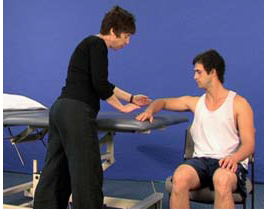AIM:
To train shoulder and elbow movements in preparation for reaching.
Rationale:
The important components for reaching include shoulder flexion/extension, horizontal abduction/adduction, protraction; and elbow flexion/extension. When reaching for objects, patients must be able to contract the muscles around the shoulder and elbow simultaneously. Task-related training is set up so the patient can practice with support from a plinth and/or manual guidance from the therapist if necessary.
Equipment:
- Adjustable height plinth
- Pillow
- Arm splint (if necessary)
- Chair
Key Points:
- Patient is positioned in supine with an arm splint used to maintain elbow extension (if necessary)
- Patient moves the shoulder and elbow in different directions
- Therapist is positioned to the side of the patient and provides manual guidance at the arm as necessary
- For protraction when the arm is paralysed/very weak, ensure manual guidance is applied at the scapula as well as the arm (ie, don’t pull on the paralysed arm)
- Therapist may provide a cue for range of movement using the hand
- Ensure forearm remains in neutral position throughout
Common Errors:
- Therapist provides too much manual guidance
- Patent internally rotates shoulder
Progression and Variety:
- Decrease/remove manual guidance
- Remove arm splint (shown on video)
- Increase amplitude of movement
- Increase speed of movement
- Position patient in sitting (shown on video)
